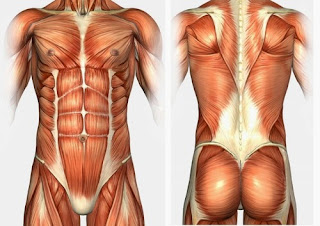
Inside-Out Movement
Balance and stability issues often come from outside-in motor patterning. When movement is instigated by the hands and feet instead of the trunk, there’s a feedback malfunction. The core reacts to the limbs. Without the stiffness and stability of the torso, the hands and feet are limited in their capability to grab, push, and pull. Without the stomach, back, butt and scapula, your body relies on ligaments being marionetted by the hands and feet.
 |
| photo credit: drawsketch.about.com |
The abdominal group should lift the arms or legs off the ground, whether in a single leg stance or amoeba crawl. If it isn’t active before the hand/foot raise, you get a hip sag or a torso collapse.
The proprioceptors in the hands and feet help reinforce core positioning. Dewey’s back hardly shifts throughout the entire sequence here. That wouldn’t happen if it was reacting. His torso tension keeps the movement fluid, both propelling the limbs and anticipating stability needs in their absence.Anytime you do a single arm or single leg exercise you’re also doing core work. SOMETHING has to be happening to keep you from shifting or falling over.
When looking at an easier movement like the in-line lunge, it’s often challenging enough to maintain your stance without touching your back knee to the ground. Cuing folks to ‘grip with the feet’ is hit or miss, but I always get more stabilization and balance out of people if I can get them to get their back butt cheek fired up:
Outside-in movement relies on the feet and hands to lead the mid-section. Save your shoulders and hips by engaging the abs and core stabilizers. Our midsection is full of muscles for a reason. Learn to use your anatomy and everything becomes easier.
1. Try any full body movement or exercise (squat, deadlift, lunge, chin, pushup, etc).
2. Follow it up with any applicable inside-out movement like the ones presented here.
3. Retest the movement and see if it feels different.
I’ll bet my hat there’s a positive change. Feel free to leave a comment if it doesn’t.



